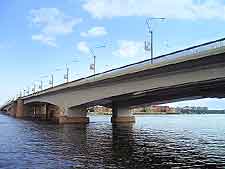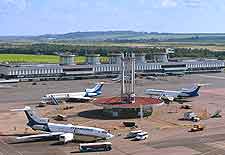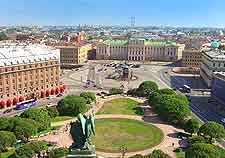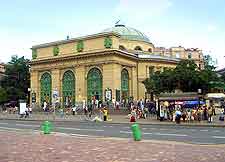Getting Around, St. Petersburg Travel, Transport and Car Rental
(St. Petersburg, North-Western Federal District, Russia)

The public transport network in St. Petersburg is well laid out and comprises metro trains, buses, trams and also electric trolleybuses. Those choosing to travel on trams around central St. Petersburg will immediately notice that they are a more relaxed and considerably slower way to travel in the city, often proving to be ideal for sightseeing and reaching local attractions.
Public transport in St. Petersburg allows you to travel around freely during the day, although at night, do bear in mind that the metro trains cease running just after midnight and do not start again until just after 05:30 in the morning. You should also note that many of the bridges spanning the River Neva also close for several hours in the middle of the night.

Pulkovo Airport (LED) / Arriving by Air
Address: 18 / 4 Pilotov Street / Pulkovskoye Shosse, St. Petersburg, RU-196210, Russia, RU
Tel: +7 0812 333 2222
A busy international airport located around 20 km / 12 miles to the south of St. Petersburg city centre,
Pulkovo Airport is currently the third busiest airport in the whole of the Russian Federation, with annual passenger figures of over 9.5 million. The two separate passenger terminals, Pulkovo 1 (domestic) and Pulkovo 2 (international), are home to almost 70 different airlines, with the largest choice of destinations being offered by the Russian airlines of both JSC Transaero and Rossiya.
Public transport at St. Petersburg's airport is extremely cheap and city buses use routes 39 (Pulkovo 1) and 13 (Pulkovo 2), while rapid metro buses are also available and connect the underground train stations of Moskovskaya, Pushkinskaya and also Tekhnologichesky Institut. Moskovskaya is the nearest metro station and offers a good way to avoid some lengthy traffic jams.

Car Rental
If you choose to rent a car upon arrival at Pulkovo Airport, or book ahead prior to your flight, you will soon realise that traffic congestion is a rather unwanted attraction in St. Petersburg. Driving and parking around the city centre is best avoided if at all possible, although if it is your intent to use your hire car to travel outside of the city and properly explore Russia's North-Western Federal District, visiting destinations such as Gatchina, Petrodvorets and Zelenogorsk, then a car is perfect and hard to match in terms of sheer convenience and practicality, especially if you have luggage or a picnic to transport.
Buses, Trams and Trolleybuses
Buses, trams and trolleybuses are especially popular forms of public transport in St. Petersburg and much used by local Russians. Tickets are usually sold by either a conductor or driver, who always appreciate it if you can hand over the exact change. Whilst buses and trolleybuses offer extremely good value, they can often become quite crowded and so you should be prepared to stand at the busiest times.

Metro Trains and Subway
The subway system in St. Petersburg is actually Russia's second-biggest underground network of trains after Moscow and is the preferred mode of transport for many, since it is usually the cheapest by far. Subway trains travel to their destinations quickly and run at regular intervals, especially during rush hours, where trains arrive almost seemingly seconds apart, although at these busy times, overcrowding is often a problem and passengers are almost squeezed into the carriages as the doors shut.
Taxis
Taxi transport is readily available in St. Petersburg, both day and night, although for many, the expensive rates are rather prohibitive. However, an increasingly popular alternative are 'route taxis', which are actually small minibuses seating up to 20 passengers. Route taxis can be hailed from the street and only stop when requested. It is normal to pay for route taxis as you step on and before you actually start to travel.
 The public transport network in St. Petersburg is well laid out and comprises metro trains, buses, trams and also electric trolleybuses. Those choosing to travel on trams around central St. Petersburg will immediately notice that they are a more relaxed and considerably slower way to travel in the city, often proving to be ideal for sightseeing and reaching local attractions.
The public transport network in St. Petersburg is well laid out and comprises metro trains, buses, trams and also electric trolleybuses. Those choosing to travel on trams around central St. Petersburg will immediately notice that they are a more relaxed and considerably slower way to travel in the city, often proving to be ideal for sightseeing and reaching local attractions.



